Economic Feasibility of Renewable Electricity Generation Systems for Local Government Office: Evaluation of the Jeju Special Self-Governing Province in South Korea
Abstract
:1. Introduction
2. Main Government Offices of Jeju Special Self-Governing Province
2.1. Geographical Location and Facilities
2.2. Load Information
2.3. Solar Resource Information
2.4. Wind Resource Information
3. Simulation Background
3.1. Annual Real Interest Rate
3.2. Economic Evaluation Outputs: COE and NPC
3.3. Other Assumptions for the Simulation
3.4. Information on Cost of Components
4. Renewable Electricity Generation System
4.1. Simulation Result 1: An Independent Case
4.2. Simulation Result 2: A Grid-Connected Case
5. Discussion and Conclusions
- In order to utilize the grid connection, strategic plans for the gradual installation of renewable electricity generation systems should be established and implemented.
- Dependence on the current grid connection should be gradually reduced.
- The current grid connection should be used for selling the electricity generated using the renewable electricity generation facilities.
Acknowledgments
Author Contributions
Conflicts of Interest
References
- Korea Ministry of Government Legislation. The Act on The Promotion of the Development, Use and Diffusion of New and Renewable Energy. Available online: http://www.law.go.kr/lsInfoP.do?lsiSeq=150378#0000 (accessed on 4 May 2016).
- Huh, S.Y.; Lee, J.; Shin, J. The economic value of South Korea’s renewable energy policies (RPS, RFS, and RHO): A contingent valuation study. Renew. Sustain. Energy Rev. 2015, 50, 64–72. [Google Scholar] [CrossRef]
- Han, S.; Shin, H.W. Policy trends of renewable energy in Korea. In Proceedings of the 2014 International Conference on Renewable Energy Research and Application, Milwaukee, WI, USA, 19–22 October 2014.
- Chen, W.M.; Kim, H.; Yamaguchi, H. Renewable energy in eastern Asia: Renewable energy policy review and comparative SWOT analysis for promoting renewable energy in Japan, South Korea, and Taiwan. Energy Policy 2014, 74, 319–329. [Google Scholar] [CrossRef]
- The Ministry of Trade, Industry and Energy in South Korea. The Fourth Renewable Energy Plan in Korea. Available online: http://motie.go.kr/common/download.do?fid=bbs&bbs_cd_n=16&bbs_seq_n=79321&file_seq_n=346 (accessed on 4 May 2016).
- Yoo, K.; Park, E.; Kim, H.; Ohm, J.Y.; Yang, T.; Kim, K.J.; Chang, H.J.; del Pobil, A.P. Optimized renewable and sustainable electricity generation systems for Ulleungdo island in South Korea. Sustainability 2014, 6, 7883–7893. [Google Scholar] [CrossRef]
- Bae, K.; Shim, J.H. Economic and environmental analysis of a wind-hybrid power system with desalination in Hong-do, South Korea. Int. J. Precis. Eng. Manuf. 2012, 13, 623–630. [Google Scholar] [CrossRef]
- Choi, H.J.; Han, G.D.; Min, J.Y.; Bae, K.; Shim, J.H. Economic feasibility of a PV system for grid-connected semiconductor facilities in South Korea. Int. J. Precis. Eng. Manuf. 2013, 14, 2033–2041. [Google Scholar] [CrossRef]
- Jeju Special Self-Governing Province. Jejudo-LG, Cooperation for New & Renewable Energy Industry: Global Eco Platform Jeju. Available online: https://www.jeju.go.kr/news/bodo/list.htm;jsessionid=3OVghpPTNGwXJM54umkuXcPeW0KvMQAxTViB2ZAJpzNJJZPWQMf1ID3nm0MrjuaB.was1_servlet_engine1?page=272&act=download&seq=489938&no=1 (accessed on 19 September 2016).
- Jeju Special Self-Governing Province. Carbon Free Island Jeju by 2030. Available online: http://www.ksga.org/down/down.asp?file=Carbon%20Free%20Island%20Jeju%20by%202030.pdf (accessed on 4 May 2016).
- Ahmed, M.A.; Kang, Y.C.; Kim, Y.C. Modeling and simulation of communication networks for use in integrating high wind power generation into a power grid. J. Renew. Sustain. Energy 2015, 7. [Google Scholar] [CrossRef]
- Yang, J. News Jeju Focus. Available online: http://m.newsjeju.net/news/articleView.html?idxno=184496 (accessed on 4 May 2016).
- Dursun, B. Determination of the optimum hybrid renewable power generating systems for Kavakli campus of Kirklareli University, Turkey. Renew. Sustain. Energy Rev. 2012, 16, 6183–6190. [Google Scholar] [CrossRef]
- Yoshino, N.; Taghizadeh-Hesary, F. Effectiveness of the easing of monetary policy in the Japanese economy, incorporating energy prices. J. Comp. Asian Dev. 2015, 14, 227–248. [Google Scholar] [CrossRef]
- Justiniano, A.; Primiceri, G.E. Measuring the equilibrium real interest rate. Econ. Perspect. 2010, 34, 14–27. [Google Scholar]
- Das, H.S.; Yatim, A.H.M.; Tan, C.W.; Lau, K.Y. Proposition of a PV/tidal powered micro-hydro and diesel hybrid system: A southern Bangladesh focus. Renew. Sustain. Energy Rev. 2016, 53, 1137–1148. [Google Scholar] [CrossRef]
- Park, E.; Yoo, K.; Ohm, J.Y.; Kwon, S.J. Case study: Renewable electricity generation systems on Geoje Island in South Korea. J. Renew. Sustain. Energy 2016, 8. [Google Scholar] [CrossRef]
- Park, E.; Kwon, S.J. Towards a Sustainable Island: Independent optimal renewable power generation systems at Gadeokdo Island in South Korea. Sustain. Cities Soc. 2016, 23, 114–118. [Google Scholar] [CrossRef]
- Park, E.; Kwon, S.J. Renewable electricity generation systems for electric-powered taxis: The case of Daejeon metropolitan city. Renew. Sustain. Energy Rev. 2016, 58, 1466–1474. [Google Scholar] [CrossRef]
- Li, C.; Ge, X.; Zheng, Y.; Xu, C.; Ren, Y.; Song, C.; Yang, C. Techno-economic feasibility study of autonomous hybrid wind/PV/battery power system for a household in Urumqi, China. Energy 2013, 55, 263–272. [Google Scholar] [CrossRef]
- Chung, M.H.; Rhee, E.K. Potential opportunities for energy conservation in existing buildings on university campus: A field survey in Korea. Energy. Build. 2014, 78, 176–182. [Google Scholar] [CrossRef]
- Ahn, J.; Woo, J.; Lee, J. Optimal allocation of energy sources for sustainable development in South Korea: Focus on the electric power generation industry. Energy Policy 2015, 78, 78–90. [Google Scholar] [CrossRef]
- Ku, S.J.; Yoo, S.H. Willingness to pay for renewable energy investment in Korea: A choice experiment study. Renew. Sustain. Energy Rev. 2010, 14, 2196–2201. [Google Scholar] [CrossRef]
- Oh, S.D.; Yoo, Y.; Song, J.; Song, S.J.; Jang, H.N.; Kim, K.; Kwak, H.Y. A cost-effective method for integration of new and renewable energy systems in public buildings in Korea. Energy Build. 2014, 74, 120–131. [Google Scholar] [CrossRef]
- Park, Y.C.; Kim, D.S.; Huh, J.; Kim, Y.G. New and renewable energy policies of Jeju island in Korea. In Proceedings of the World Renewable Energy Congress, Linköping, Sweden, 8–13 May 2011.
- Lee, J.; Kim, S.B.; Park, G.L.; Park, C.J. Monitoring-based temporal prediction of power entities in smart grid cities. In Proceedings of the 2012 ACM Research in Applied Computation Symposium, New York, NY, USA, 23–26 October 2012.
- Kim, H.C.; Lim, D.S. A study on the economic effects of new/renewable energy industry of Jeju: The case of photovoltaic and wind-power of Jeju. Tamla Munhwa 2014, 47, 299–324. [Google Scholar]
- Park, E.; Kwon, S.J. Solutions for optimizing renewable power generation systems at Kyung-Hee University’s Global Campus, South Korea. Renew. Sustain. Energy Rev. 2016, 58, 439–449. [Google Scholar] [CrossRef]
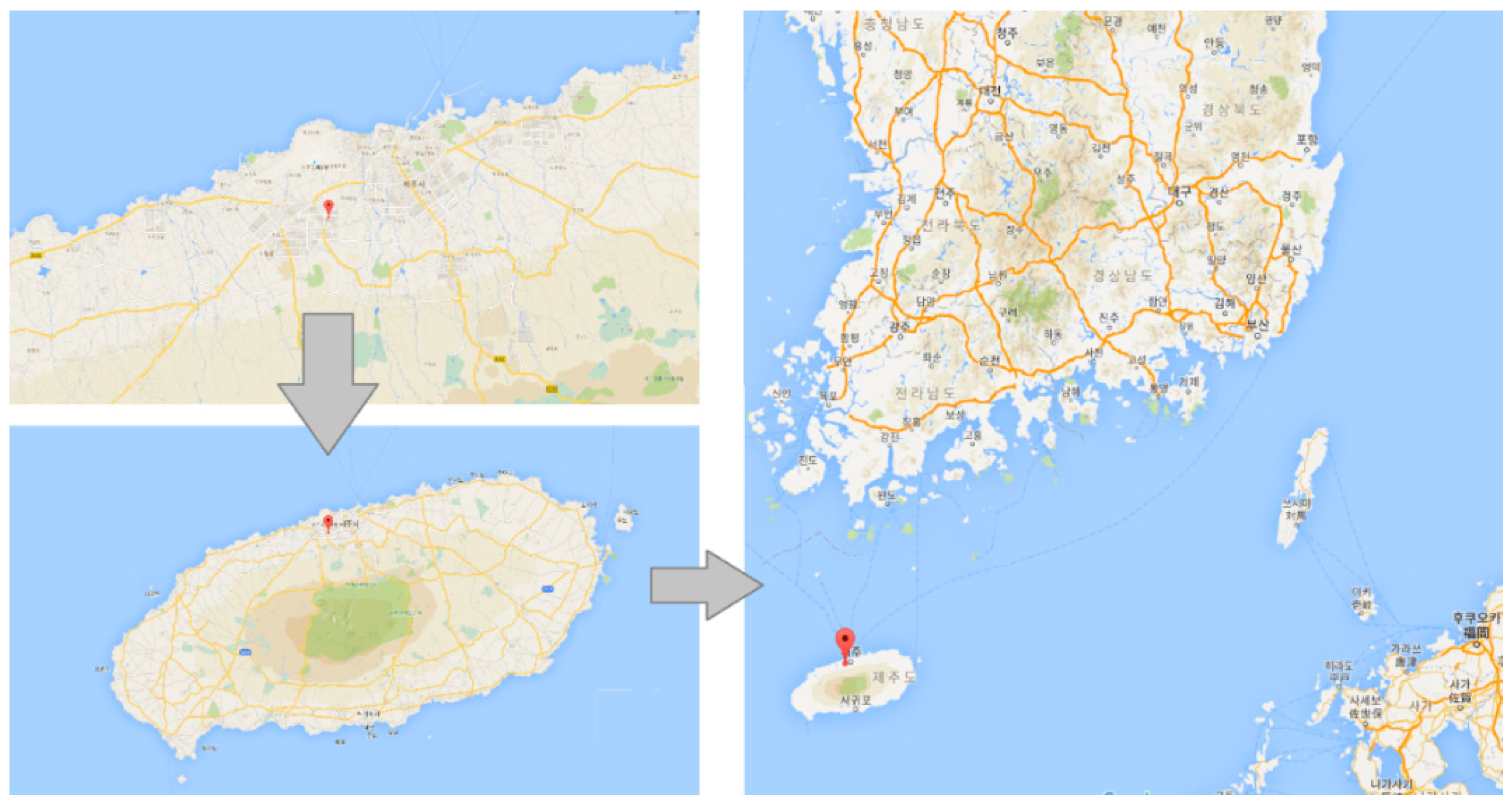



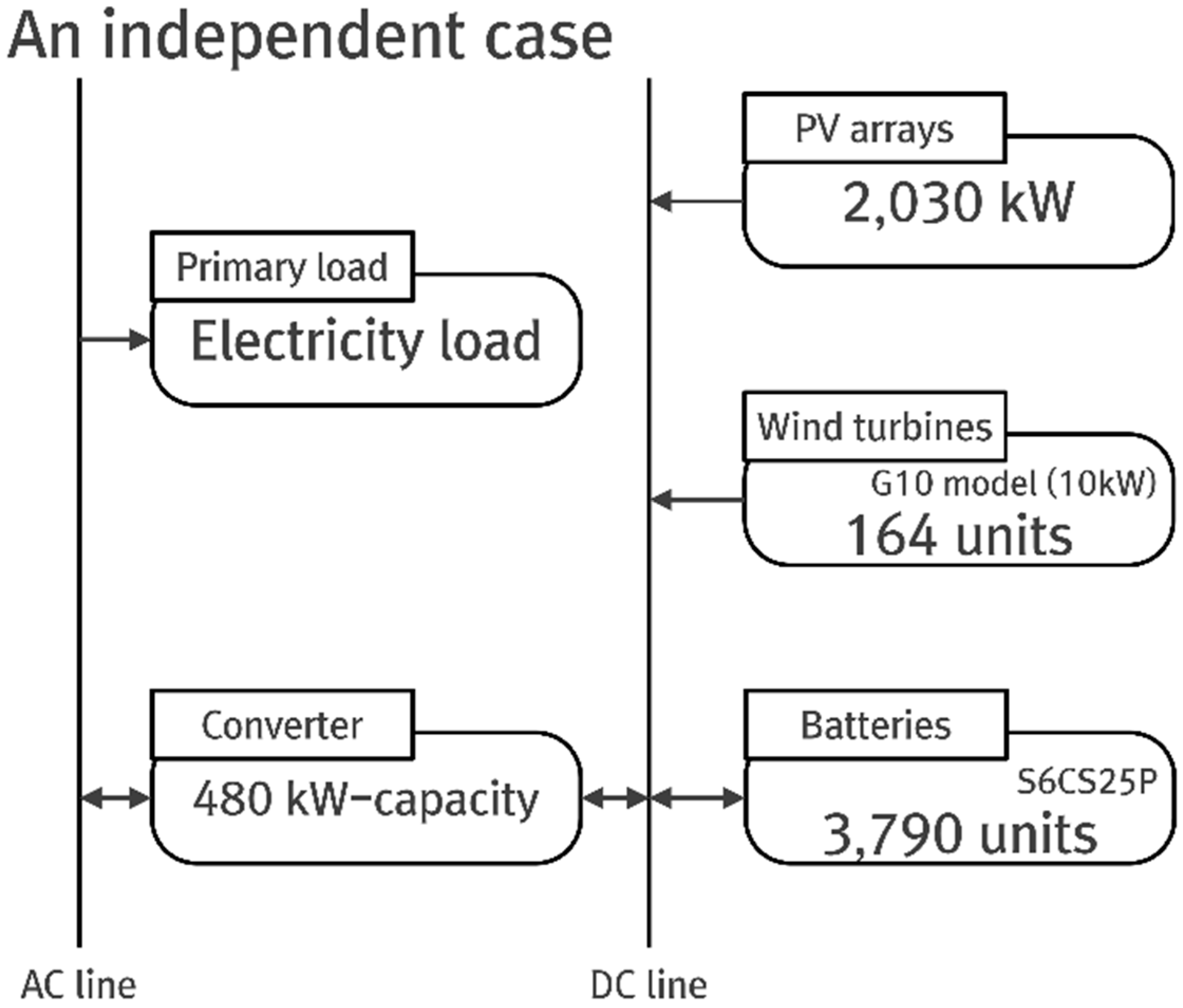
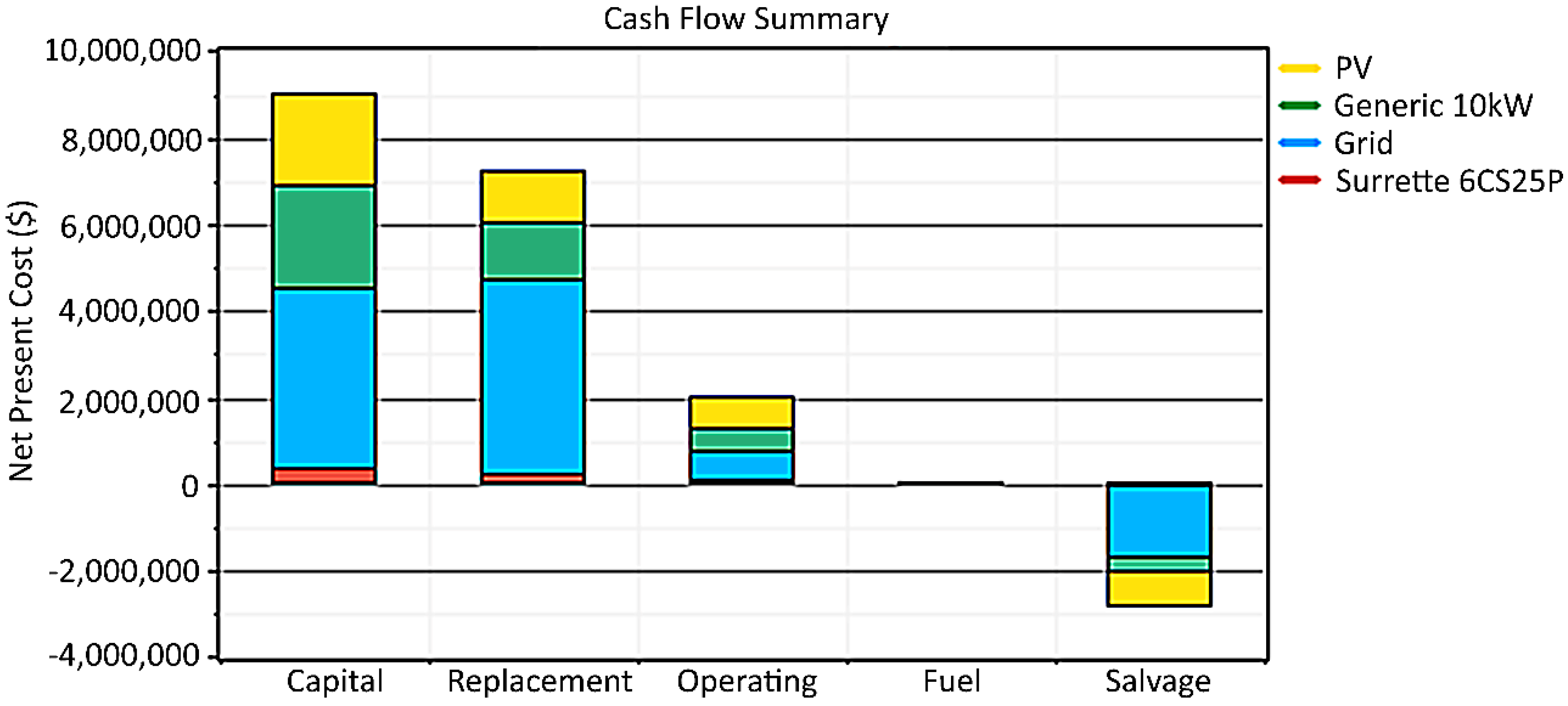

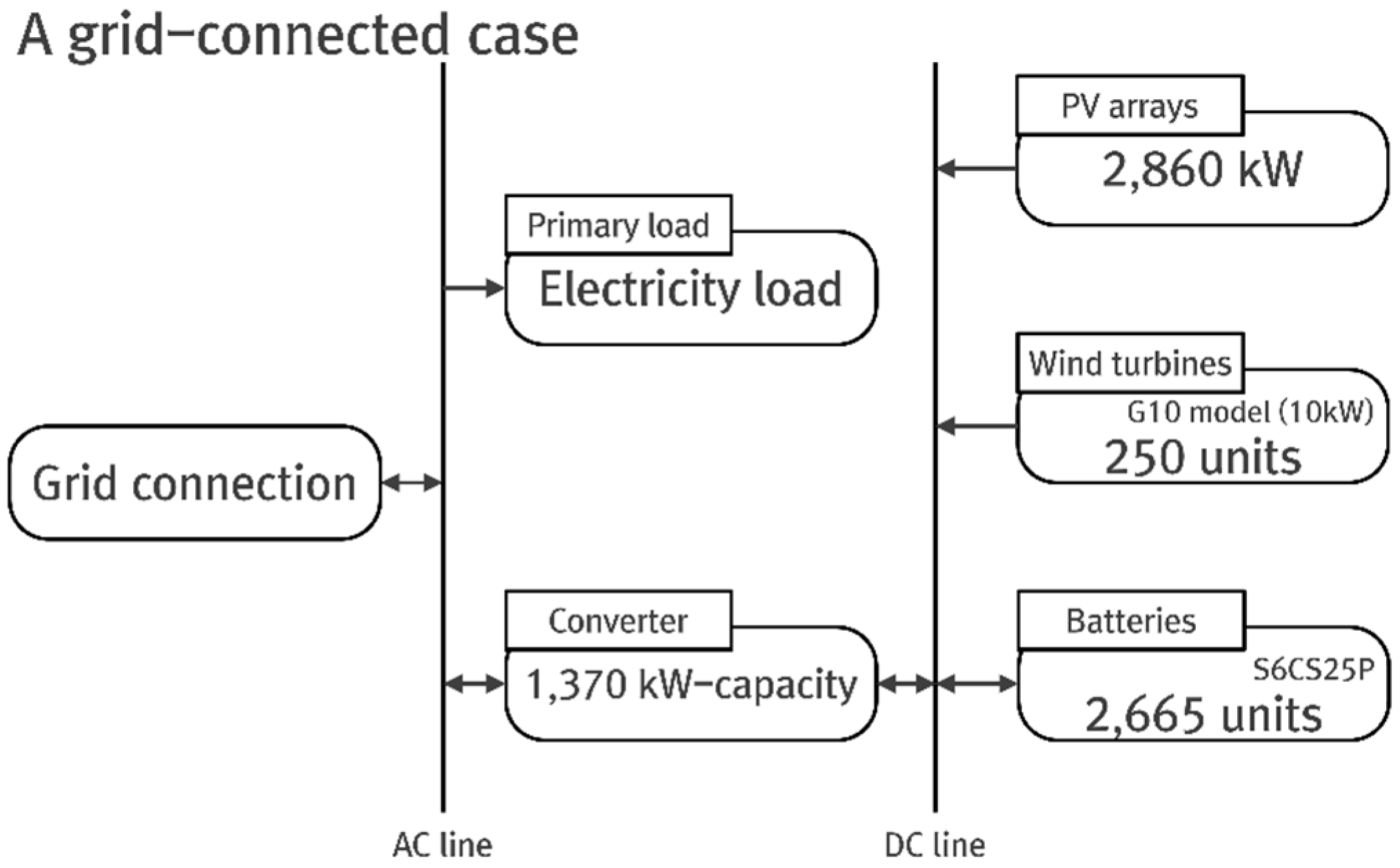
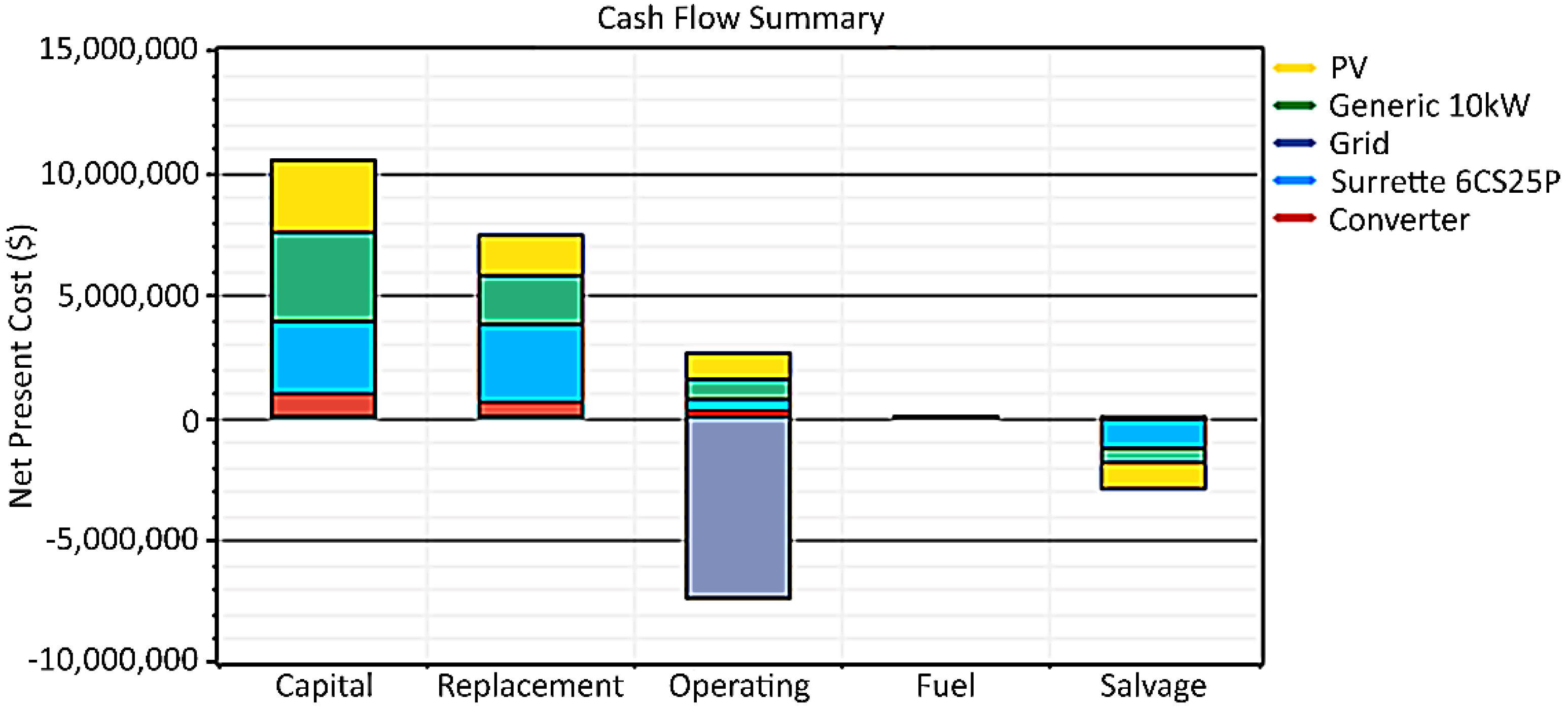

| Year | 2014 | 2015 | 2016 | 2017 | 2018 | 2019 | 2020 |
|---|---|---|---|---|---|---|---|
| Ratio | 12% | 15% | 18% | 21% | 24% | 27% | 30% |
| Inputted Parameters | ||
| Economic | Technical | Environmental |
| Annual real interest rate (%), Capital and operation and management „costs ($), Project lifetime (years), Capacity shortage penalty ($ per kWh), Emissions penalty for carbon dioxide, monoxide, unburned hydrocarbons, particulate matter, sulfur dioxide, nitrogen oxides ($ per ton), Diesel price ($ per liter) PV array, battery, converter, generator, wind and hydro turbines: Capital cost ($), Replacement cost ($), Operation & management cost ($), Lifetime (years) Grid: Price ($ per kWh), Sellback ($ per kWh), Interconnection charge ($), Standby charge ($ per year) | PV array: Derating factor (%), Slope (degrees), Ground reflectance (%) Wind turbine: Hub height (meters), Rated power (kW) Battery: Nominal voltage (V), Nominal capacity (Ah or kWh) Converter: Efficiency (%) Electricity load: Hourly electricity consumption (kW) Generator: Minimum load ratio (%) Grid: Gas emissions (carbon dioxide, carbon monoxide, unburned hydrocarbons, particulate matter, sulfur dioxide, and nitrogen oxides; g per kWh) Hydro turbine: Available head (meters), Design flow rate (liters per second), Minimum and maximum flow ratio (%), Efficiency (%) | Stream flow of hydro resource (liters per second), Monthly average wind speed (m/s), Clearness of solar resource, Daily radiation of solar resource (kWh/m2/d), Latitude and longitude |
| Outcomes | ||
| Economic | Technical | Environmental |
| Total net present costs ($), annualized costs ($ per year) of all components and system in capital, replacement, operation & management, salvage, Cost of energy ($ per kWh), Renewable fraction (%) | Annual electricity production of all components (kWh), Annual electricity consumption and fraction of all components including excess electricity, unmet load, and capacity shortage (kWh, %) PV array, hydro and wind turbine: Rated capacity (kW), Mean, min. and max. output (kW), PV (or wind, hydro) penetration (%), Hours of operation (hours per year), Levelized cost ($ per kWh) Battery: Strings in parallel (#), Nominal capacity (kWh), Lifetime throughput (kWh), Energy in and out (kWh per year), Storage depletion and losses (kWh per year), Annual throughput (kWh per year), Expected life (years) Converter: Mean, minimum, and maximum output (kW), Capacity factor (%), Hours of operation (hours per year), Losses, energy in and out (kWh per year) | Emissions of carbon dioxide, monoxide, unburned hydrocarbons, particulate matter, sulfur dioxide, nitrogen oxides (kg per year) |
| Components | Index |
|---|---|
| PV arrays (kW) | 2030 |
| Wind turbines: type 1 (Generic 10 kW; #) | 164 |
| Wind turbines: type 2 (WES 5 Tulipo; #) | 0 |
| Batteries (#) | 3790 |
| Converter (kW) | 480 |
| Operating cost (O and M; $ per year) | 370,600 |
| Initial capital ($) | 9,014,500 |
| Total NPC ($) | 15,467,821 |
| COE ($/kWh) | 0.306 |
| Renewable fraction (%) | 100% |
| Component | Capital ($) | Replacement ($) | O and M ($) | Salvage ($) | Total ($) | |
|---|---|---|---|---|---|---|
| Total Period | PV array | 2,131,500 | 1,180,161 | 706,974 | –763,513 | 3,255,122 |
| Wind turbine: type 1 (Generic 10 kW) | 2,378,000 | 1,315,818 | 571,152 | –326,364 | 3,938,606 | |
| Wind turbine: type 2 (WES 5 Tulipo) | – | – | – | – | – | |
| Battery | 4,169,000 | 4,522,661 | 659,959 | –1,659,283 | 7,692,337 | |
| Converter | 336,000 | 215,666 | 83,583 | –53,492 | 581,757 | |
| System | 9,014,500 | 7,234,306 | 2,021,668 | –2,802,651 | 15,467,821 | |
| Annual Period | PV array | 122,408 | 67,774 | 40,600 | –43,847 | 186,935 |
| Wind turbine: type 1 (Generic 10 kW) | 136,563 | 75,565 | 32,800 | –18,742 | 226,186 | |
| Wind turbine: type 2 (WES 5 Tulipo) | – | – | – | – | – | |
| Battery | 239,417 | 259,727 | 37,900 | –95,289 | 441,755 | |
| Converter | 19,296 | 12,385 | 4800 | –3072 | 33,409 | |
| System | 517,684 | 415,451 | 116,100 | –160,950 | 888,285 |
| Components | Electricity Production (kWh)/Fraction (%) |
|---|---|
| PV arrays | 2,738,148, 45% |
| Wind turbines | 3,290,134, 55% |
| Total | 6,028,282, 100% |
| Quantity | Value (kWh) |
| Excess electricity | 2,524,625 |
| Unmet load | 2192 |
| Capacity shortage | 2887 |
| Components | Index |
|---|---|
| PV arrays (kW) | 2860 |
| Wind turbines: Type 1 (Generic 10 kW; #) | 250 |
| Wind turbines: Type 2 (WES 5 Tulipo; #) | 0 |
| Batteries (#) | 2665 |
| Converter (kW) | 1370 |
| Operating cost ($ per year) | –13,112 |
| Initial capital ($) | 10,518,500 |
| Total NPC ($) | 10,290,187 |
| COE ($/kWh) | 0.204 |
| Renewable fraction (%) | 100% |
| Component | Capital ($) | Replacement ($) | O and M ($) | Salvage ($) | Total ($) | |
|---|---|---|---|---|---|---|
| Total Period | PV array | 3,003,000 | 1,662,689 | 996,032 | –1,075,688 | 4,586,033 |
| Wind turbine: type 1 | 3,625,000 | 2,005,819 | 870,658 | –497,506 | 6,003,971 | |
| Wind turbine: type 2 | – | – | – | – | – | |
| Grid | 0 | 0 | –7,369,239 | 0 | –7,369,239 | |
| Battery | 2,931,500 | 3,180,182 | 464,061 | –1,166,752 | 5,408,991 | |
| Converter | 959,000 | 615,546 | 238,560 | –152,675 | 1,660,431 | |
| System | 10,518,500 | 7,464,236 | –4,799,928 | –2,892,621 | 10,290,187 | |
| Annual Period | PV array | 172,456 | 95,485 | 57,200 | –61,774 | 263,367 |
| Wind turbine: type 1 | 208,176 | 115,190 | 50,000 | –28,571 | 344,795 | |
| Wind turbine: type 2 | – | – | – | – | – | |
| Grid | 0 | 0 | –423,200 | 0 | –423,200 | |
| Battery | 168,350 | 182,631 | 26,650 | –67,004 | 310,627 | |
| Converter | 55,073 | 35,349 | 13,700 | –8768 | 95,354 | |
| System | 604,055 | 428,655 | –275,650 | –166,117 | 590,943 |
| Components | Electricity Production (kWh) and Fraction |
|---|---|
| PV arrays | 3,857,697 (43%) |
| Wind turbines | 5,015,423 (57%) |
| Grid purchases | 0 (0%) |
| Total | 8,873,120 (100%) |
| Load | Consumption (kWh per year) and fraction |
| AC primary load | 2,898,654 (48%) |
| Grid sales | 3,078,084 (52%) |
| Quantity | Value (kWh) |
| Excess electricity | 1,985,863 |
| Unmet load | 2351 |
| Capacity shortage | 2893 |
| Month | Energy Sold (kWh) | Net Purchases (kWh) | Energy Charge ($) |
|---|---|---|---|
| January | 284,276 | –284,276 | –39,085 |
| February | 278,046 | –278,046 | –38,228 |
| March | 303,852 | –303,852 | –41,776 |
| April | 256,603 | –256,603 | –35,280 |
| May | 244,526 | –244,526 | –33,619 |
| June | 217,538 | –217,538 | –29,909 |
| July | 199,996 | –199,996 | –27,497 |
| August | 222,079 | –222,079 | –30,533 |
| September | 210,954 | –210,954 | –29,004 |
| October | 272,344 | –272,344 | –37,444 |
| November | 245,480 | –245,480 | –33,751 |
| December | 342,389 | –342,389 | –47,074 |
| Total (annual) | 3,078,084 | –3,078,084 | –423,200 |
© 2017 by the authors; licensee MDPI, Basel, Switzerland. This article is an open access article distributed under the terms and conditions of the Creative Commons Attribution (CC-BY) license (http://creativecommons.org/licenses/by/4.0/).
Share and Cite
Park, E.; Kim, K.J.; Kwon, S.J.; Han, T.; Na, W.S.; Del Pobil, A.P. Economic Feasibility of Renewable Electricity Generation Systems for Local Government Office: Evaluation of the Jeju Special Self-Governing Province in South Korea. Sustainability 2017, 9, 82. https://doi.org/10.3390/su9010082
Park E, Kim KJ, Kwon SJ, Han T, Na WS, Del Pobil AP. Economic Feasibility of Renewable Electricity Generation Systems for Local Government Office: Evaluation of the Jeju Special Self-Governing Province in South Korea. Sustainability. 2017; 9(1):82. https://doi.org/10.3390/su9010082
Chicago/Turabian StylePark, Eunil, Ki Joon Kim, Sang Jib Kwon, Taeil Han, Wongi S. Na, and Angel P. Del Pobil. 2017. "Economic Feasibility of Renewable Electricity Generation Systems for Local Government Office: Evaluation of the Jeju Special Self-Governing Province in South Korea" Sustainability 9, no. 1: 82. https://doi.org/10.3390/su9010082
APA StylePark, E., Kim, K. J., Kwon, S. J., Han, T., Na, W. S., & Del Pobil, A. P. (2017). Economic Feasibility of Renewable Electricity Generation Systems for Local Government Office: Evaluation of the Jeju Special Self-Governing Province in South Korea. Sustainability, 9(1), 82. https://doi.org/10.3390/su9010082






